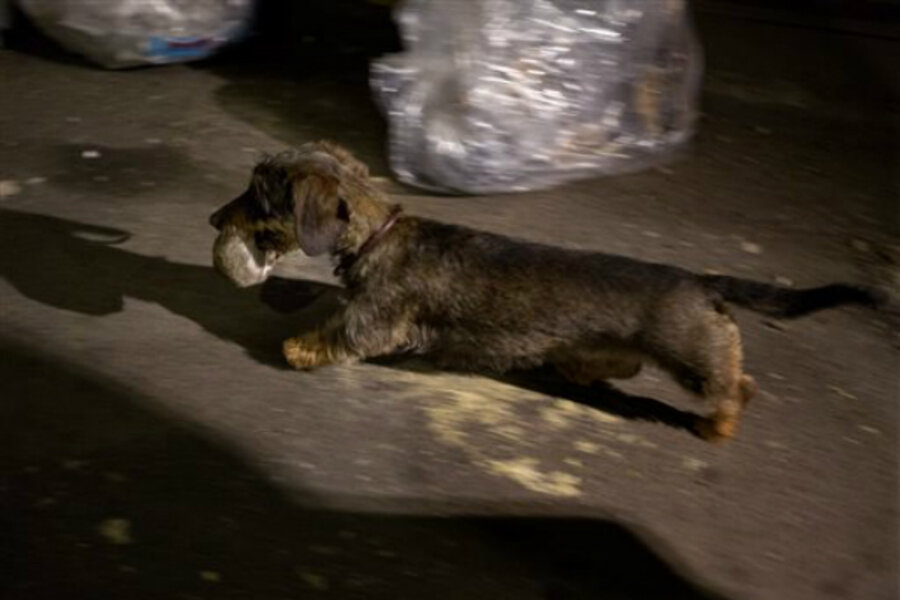NYC dogs can smell a rat and capture it too
Loading...
| New York
Bodies tense and noses twitching, the dogs sniff the fertile hunting ground before them: a lower Manhattan alley, grimy, dim, and perfect for rats. With a terse command – "Now!" – the chase is on.
Circling, bounding over, and pawing at a mound of garbage bags, the four dogs quickly have rodents on the run.
"Come on ... I mean, 'Tally ho!'" says one of their owners, Susan Friedenberg. In a whirl of barks, pants, and wagging tails, dogs tunnel among the bags and bolt down the alley as their quarry tries to scurry away.
Within five minutes, the city has two fewer rats.
In a scrappy, streetwise cousin of mannerly countryside fox hunts, on terrain far from the European farms and fields where many of the dogs' ancestors were bred to scramble after vermin and foxes, their masters sport trash-poking sticks instead of riding crops and say it's just as viable an exercise for the animals' centuries-old skills.
"It's about maintaining the breed type through actual work," says Richard Reynolds, a New Jersey-based business analyst and longtime dog breeder who might be considered the group's organizer – if it would accept being called organized.
Known with a chuckle as the Ryders Alley Trencher-fed Society — parse the acronym — the rodent-hunters have been scouring downtown byways for more than a decade, meeting weekly when weather allows.
On a couple of recent nights, an eclectic group of ratters converged on an alley near City Hall about an hour after sunset. The lineups included two border terriers; a wire-haired dachshund; a Jack Russell terrier/Australian cattle dog mix; a Patterdale terrier, an intense, no-nonsense breed that's uncommon in this country; and a feist, a type of dog developed in the American South to tree squirrels.
"Get 'im! Go!" Serge Lozach yelled as his cairn terrier, Hudson, streaked down an alley after a fleeing rat. Unlike many of the other owners, Lozach doesn't breed or show dogs, but he has taken Hudson to several alley hunts.
"I like watching him have fun," Lozach said.
Although the dogs have hunting instincts, it takes training to capitalize on them. Just because your pet runs after backyard squirrels doesn't mean it could ever catch one.
When at its best, the alley pack works together. One dog will sniff out a rat and signal its whereabouts, often by barking. Another leaps at the hideaway to rout the quarry, and then a third lurches to catch it as it flees. A rat that scuttles into the open might get caught in a rundown, or even a tug of war, between dogs that circle and flank it.
After making a kill with a bite or a shake, the hunters trot back, rat in mouth, and allow their owners to take it from their jaws. The night's kill ends up in a trash bin.
There's no official estimate of how many rats rove the city's streets, basements, parks, and subways. But there are plenty.
Officials have tried a number of innovative tactics to rout them, including a 2007 city Health Department initiative that sent inspectors with hand-held computers to map infestations in a Bronx neighborhood and then followed up with owners to address the problems.
Recently, the Metropolitan Transportation Authority agreed to let an Arizona-based company test a form of rat birth control by setting out bait in some subway stations this summer.
But the terrier forays are an unofficial undertaking, and participants say they're less about killing rats than giving dogs the experience of chasing them. The Health Department declined to comment on the hunts.
The idea has a long history. A noted 1851 examination of working-class life in London describes rat-catchers working the city's streets with ferrets and terriers. More recently, a rat-catching dachshund got attention in Seattle when its owner happened by while City Councilman Tom Rasmussen was checking out a downtown cleanup program in 2010. Rasmussen snapped a picture of the dog, rat in mouth, and posted the photo on his website.
There's even an American dog breed called a rat terrier, though its origins lie on farms.
Rat-tracking recently became an official canine sport, called "barn hunt." Dogs get two minutes to sniff around a hay-bale maze and indicate where they smell a rat concealed in a crush-proof, aerated tube; the dog never catches the quarry. Dozens of dogs competed in the first trials this past month in Columbia, Mo.
While dog owners may see it as time-honored pursuit, rat-hunting riles animal-rights advocates. People for the Ethical Treatment of Animals, which opposes hunting in general, expressed outrage after video of a dog snatching rats in a New York City park surfaced online two years ago. PETA Spokesman Martin Mersereau calls the alley rat quests "a twisted blood sport masquerading as rodent control."
Reynolds counters that "there are lots of worse things that people do to rats," noting that poisons can sicken the animals for hours.
As for the dogs, they have sometimes gotten stuck in waste bins or tumbled into holes, and a recent night left two with scrapes. But Reynolds says none has ever been seriously hurt or fallen ill.
In one recent foray, the dogs dispatched 13 rats within about a half-hour.
The dogs prowled and prodded for about 90 more minutes before the group gave up for the night. But not to worry, said dachshund owner Trudy Kawami.
"There will always be a million rats in the naked city."





